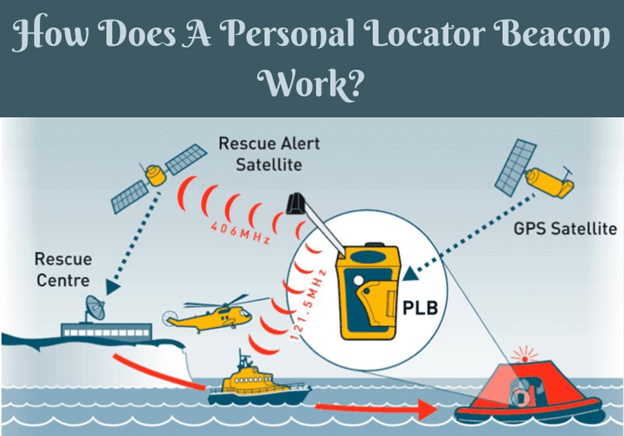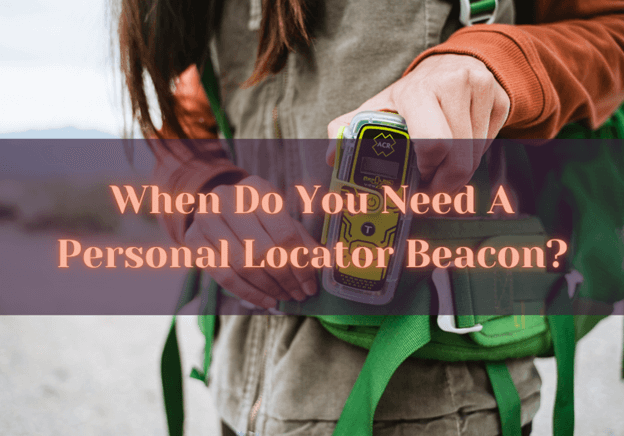Suppose you like exploring the environment, especially in areas with no phone service, and you need assistance. In that case, a personal locator beacon (PLB) will be your dearest buddy. A personal locator beacon (PLB), sometimes known as a distress beacon, is a device that may be used to inform emergency personnel if someone is in danger somewhere .
The Personal Locator Beacon (PLB) is a smaller, lighter variant of the Emergency Position Indicating Radio Beacon (EPIRB). An EPIRB is a kind of distress beacon that is often used in marine settings. Boats that sail more than two metric miles from shore must have this device.
PLB, on the other hand, is intended for hikers and people sailing close to the coast in small sea vessels such as kayaks or smaller boats. PLBs and EPIRBs perform the same functions. However, they are designed for different outside environments.
Today, we’ll look at personal locator beacon for hiking, how they work, and who they’re created for.
What Is A Personal Locator Beacon for Hiking?
A personal locator beacon is a tiny portable device that sends your geographical data to search and rescue authorities when activated. These devices are built to function on land, at sea, in the air, or in the most distant parts of the world.
Personal locator beacons use a particular emergency frequency to send out an alarm signal when your mobile phone won’t cut it – regardless of where you are.
How Does A Personal Locator Beacon Work?
Depending on the type, triggering a personal locator beacon looks different. Still, often, all you need to do is extend the antenna and switch on the device.
Instead of sending your alarm signal via the closest cell tower, the beacon talks with a network of satellites to convey your position to a local search and rescue team.
These SARSAT (Search and Rescue Satellites) satellites are part of a worldwide initiative to assist individuals in trouble all around the globe.
When these satellites receive your emergency signal, they will redirect it to the nearest receiving center on Earth.
Local User Terminals are located in these areas. When they receive an incoming signal from a SARSAT, they notify the closest Rescue Coordination Center. Local authorities may then send search and rescue personnel to your area.
This approach may vary somewhat depending on the kind of personal locator beacon used. Still, satellite technology is regular practice, and the ultimate aim remains to rescue people from potentially hazardous or life-threatening circumstances.

Who Are Personal Locator Beacons For?
These satellite-powered devices are intended for those who may become stuck in remote areas where mobile phones do not work.
They are often the best friend of downhill skiers, snowboarders, hikers, and other adventures if they get lost, wounded, trapped in an avalanche, or encounter other natural disasters.
Pilots often carry personal locator beacons with them in case their airplane crashes. And sailors keep them on board if they get lost, someone falls overboard, or the ship begins to sink.
Many offshore businesses throughout the globe require life jackets that have built-in personal locator beacons. Otherwise, you will not be permitted to leave the coast.
When Do You Need A Personal Locator Beacon?
Research suggests that an increasing number of individuals are becoming aware of the risks of today’s technological addiction, and many prefer to “disconnect” from technology on occasion to embrace nature. Again, a PLB is something you should have just in case since you can never be too cautious.
Furthermore, as advanced as we have become with our daily devices, there are still locations and situations when these technologies may be rendered worthless. There are still locations were making a 911 emergency call may be difficult. A PLB might be useful whether traveling on a camping vacation, hiking, or sailing on a cruise ship.

Is A Personal Locator Beacon Right For You?
You may be wondering whether a PLB is suited for you now that you know a little bit more about them. Here are a few factors to think about:
• Are you an experienced hiker? A PLB may not be essential if you are new to hiking. However, suppose you are an experienced hiker who often hikes alone or in remote areas. In that case, a PLB will be an excellent option. If you want to explore an unknown area or stray from the route, a PLB may provide you with some piece of mind.
• Do you have access to a mobile phone? You may not need a PLB if you usually hike with your phone. However, a PLB might be helpful if you don’t have a mobile phone or often trek in places with poor or no signal cell service.
• Can you afford it? PLBs may be costly, so you must consider if the investment is worthwhile. Prices typically vary between $300 and $400. However, remember that the peace of mind provided by a PLB is invaluable.
• Do you understand how to utilize it? If you decide to get a PLB, ensure you understand how to operate it correctly and register it. That way, you’ll be ready if you ever need to use it for real.
Overall, personal locator beacons are helpful to hikers, backpackers, boaters and everyone getting out in nature. A PLB can sometimes spell the difference between life and death.
What To Consider Before Buying A Personal Locator Beacon?
It’s vital to realize that the outdoors may be risky, especially if you don’t have reliable communications to call for help if you need it. Many regions in the wilderness have very shaky or non-existent mobile coverage.
If anything, horrible occurs to you or your team there, things might quickly turn from bad to worse. Before you leave the trailhead, it’s critical to have a robust, redundant communication strategy in place.
A reliable PLB can keep you in touch with emergency response agencies. A decent one will allow you to stay in touch with loved ones while transforming your mobile phone into a Satcom.
PLBs used to be simple press-SOS-and-hope devices that sent a one-way signal to emergency rescue agencies. Nowadays, the newest devices provide two-way texting, making it challenging to justify acquiring one-way devices.
You may issue an SOS, communicate with the rescue control center, and respond to on-scene rescuers via two-way communication. It’s possible that doing so may mean the difference between life and death in a number of situations.
Level Of Standalone Functionality:
One-way SOS beacon functionality is included in the standalone unit of all tested devices. However, two-way messaging for emergency and routine purposes is only available when paired with a smartphone and proprietary software.
It is significant because the more complicated a system, the greater the likelihood of failure. Furthermore, smartphone-dependent devices increase your power and recharging needs in the wilderness and add weight to your pack.
Communication Networks:
Verify if your equipment is satellite-only or can communicate through cellular towers and Wi-Fi. Check that two-way texting is smooth across networks for the optimum user experience among those who can.
Size And Weight:
Every ounce matters when you’re carrying everything in your backpack for days. Look for the lightest equipment that fits your demands as little as possible.
Battery Life:
Battery life differs widely amongst devices, mainly if tracking is activated. Most devices can track for many days before recharging, and most need a Micro-USB or USB-C connector. Understand that USB-C devices charge twice as quickly as Micro-USB ones.
FAQs About Personal Locator Beacons:
What Is The Price Of A Personal Locating Beacon?
Prices vary according to unit capacity. The most expensive item we looked at was about $400 for the PLB alone, while the cheapest was around $250. For emergency and non-emergency communication, most demand service contracts or subscription fees (costs vary greatly), so you should add that to the purchase and usage cost.
So, How Exactly Does One Use A PLB?
When you push the SOS button, the PLB broadcasts a strong distress signal to a global network of satellites. Both government and commercial rescue coordination centers monitor these distress signals.
The distress call is sent to an appropriate response agency, along with information about your location. In turn, they organize with local search and rescue agencies to come and find you. Remember that SAR assets vary by location, so you’ll probably receive a speedier, more competent rescue in the Tetons than you would in a less-resourced country.
When Do I Need To Utilize My Personal Locator Beacon?
Consider pressing SOS to be the equivalent of dialing 911. When you or a team member is in urgent danger of losing life, sight, or limb, and self-rescue and evacuation is not the fastest option, Use it.!.
Additional Resources
If you are looking for more tutorials, walkthroughs and troubleshooting about camping and enjoying the outdoors, here are some additional posts to check out:
Conclusion:
As a result, even if you think you’ll never need it, buying and taking a Personal Locator Beacon is like having an extra life insurance policy in your pocket. Furthermore, since they are compact and lightweight, they are simple to transport and take up little space.
However, having one of these units with you greatly increases your chances of survival in an emergency in the wilderness. You will be eternally grateful to yourself and your loved ones for thinking ahead to make this tiny technological investment in case of an unexpected disaster. Thanks for reading, if you think I forgot something or if you simply want to share a story or some advice, feel free to leave your comment below, for now, be safe and have fun.!
